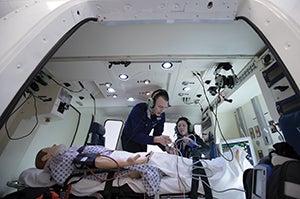launch
TAKING FLIGHT ON THE GROUND
 photo: Russell Lee
Flight nursing students Jacob Miller and Amanda Rowe
photo: Russell Lee
Flight nursing students Jacob Miller and Amanda Rowe
Rain pelted against the windows as the helicopter shook and banked to the left. Two Case Western Reserve flight-nursing students braced their feet, tending to a male patient inside the cramped fuselage as he coughed out, "I feel dizzy" above the rumble of the propellers. Minutes later, the helicopter came to a stop.
The two students stepped out of the cramped vehicle and into a large room in a campus service center. They had just completed a session in the Frances Payne Bolton School of Nursing's new critical-care flight simulator—the first in the nation built in an actual helicopter.
"It feels like the real thing," said Jacob Miller, MS, a flight nurse in Jamestown, N.Y., who is in a specialized practitioner certificate program at the nursing school. Seven other students are gaining experience in the simulator as part of an acute-care master's program with a specialty in flight nursing.
Custom built in the fuselage of a used Sikorsky S-76 helicopter, the simulator pitches and rolls to mimic turbulent conditions as students work on a high-tech mannequin, perform exams, insert breathing tubes or hook up IV lines—and at the same time learn to work in the noisy, confining, motion-sickness-inducing environment. Adding to the sense of reality are window projections that use Global Positioning System (GPS) data to provide views of selected locations and altitudes across the globe.
Faculty watching the students via a camera link can improve or worsen the medical state of the mannequin, SimMan.
Separately, Case Western Reserve biomedical engineering students are designing a laser light system to imitate helicopter rotors so flight students can practice loading and unloading patients safely.
"The simulator enhances everything covered in the classroom and gives students a chance to find real solutions, not just theoretical ones," said Stephanie Steiner, MSN (NUR '09), director of the nursing school's Dorothy Ebersbach Academic Center for Flight Nursing. "This is as close as it gets without taking off from the ground with an actual patient."
Dorothy Ebersbach (NUR '54), who served as a public health nurse after flying noncombat missions during World War II, provided gifts to the nursing school for the simulator's construction before her death in 2011. Redbird Flight Simulations, a company in Austin, Texas, also donated funds and labor to design and install the simulator's software and equipment.
Nursing school faculty believe the simulator will help demonstrate the value of formal training at a time when no national requirement exists for specialized flight-nursing education.
"Our hope is to set new standards in training critical-care transport personnel," said Celeste Alfes, DNP (NUR '10), assistant professor and director of the Learning Resource Center at the nursing school.






